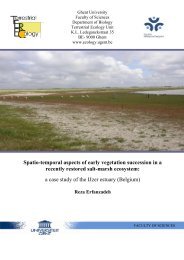PhD Arthur Decae 2010 - Ghent Ecology - Universiteit Gent
PhD Arthur Decae 2010 - Ghent Ecology - Universiteit Gent
PhD Arthur Decae 2010 - Ghent Ecology - Universiteit Gent
Create successful ePaper yourself
Turn your PDF publications into a flip-book with our unique Google optimized e-Paper software.
Discussion<br />
Simon (1903 pp. 887-888) included three genera (Ummidia, Conothele and Hebestatis) in his<br />
Pachylomereae based on the shared absence of lateral sternal sigilla. Raven 1985 followed<br />
this classification but used the eye tubercle and saddle tibia. However, the probable type<br />
specimen in Simon’s collection (AR12317 MNHN examined) labelled Hebestatis theveneti<br />
actually possesses lateral sternal sigilla and furthermore shows sufficient morphological<br />
differences from both Ummidia and Conothele, (dorsal saddle on tibia III not pronounced and<br />
not glabrous, absence of curvy spines, absence of tarsal clavate trichobothria, absence of<br />
centrally sclerotized spermathecae) to exclude the genus Hebestatis from the Ummidiinae.<br />
The taxonomy of the genus Ummidia in the western Mediterranean has been disputed from<br />
the start. Shortly after Westwood 1840 had presented the discovery and description of his<br />
Actinopus aedificatorius (now Ummidia aedificatoria) from Morocco to the Entomological<br />
Society of London, Walckenaer 1842 explicitly expressed his doubts about these findings.<br />
Walckenaer suspected that Westwood was mistaken in either the origin or the identity of the<br />
species described (see also Westwood 1840: 181). Westwood had obtained the specimens he<br />
presented and described from Mr Drummond Hay, H.M.’s agent and Consul-general at<br />
Tangiers in the far northwest of Morocco. Furthermore, he classified this newly discovered<br />
species as belonging “to the same genus as Mr. Sell’s Jamaica species, to which it is so<br />
closely allied as scarcely to present any specific distinction beyond that of size” (Westwood<br />
1840: 174-175). Mr. Sell’s Jamaican species is now known as Ummidia nidulans (Fabricius<br />
1787) and the fact that Westwood regarded his Moroccan species so closely allied with a<br />
Caribbean species caused much skepticism among the leading arachnologists at that time. The<br />
discovery of several other Ummidia species in the Americas in the 19 th century (e.g. Ausserer<br />
1871: 146-147) reinforced the idea that Ummidia was naturally restricted in its distribution to<br />
the New World and that the incidental finding of Ummidia east of the Atlantic must be the<br />
result of human mediated introduction. This idea was most vividly expressed in the work of<br />
Simon:<br />
“le genre Pachylomerus, qui est assez nombreux, est américain, il a cependant un<br />
représentant au Japon (d’après Dönitz) et un autre dans la région<br />
méditerranéenne occidentale (Algérie et Espagne), mais ce dernier paraît y avoir<br />
été introduit en même temps que les Opuntia et les Agave d’origine américaine”<br />
(Simon 1892: p.86).<br />
In short, Simon regarded Pachylomerus (Ummidia) in the western Mediterranean as an<br />
American species that was introduced probably with imports of ornamental plants. Central in<br />
Simon’s opinion was his conviction that only one Ummidia species (U. aedificatoria<br />
Westwood 1840), inhabits the western Mediterranean. In forming his opinion about Ummidia<br />
in the western Mediterranean, Simon had apparently overlooked the work of Lucas who had<br />
described a second Ummidia species in North Africa, this time from eastern Algeria. Lucas<br />
(1846: 96-97) had collected this new species near the town of Bône (now Annaba) over<br />
1200km east of the locality from where Westwood had obtained U. aedificatoria. Lucas<br />
furthermore was well aware of the diagnostic differences between his new species, that he<br />
described as Actinopus algerianus (now Ummidia algeriana) and Westwood’s U.<br />
aedificatoria. He distinguished the two species on the grounds of differences in the<br />
morphology of the rastellum, the curved anterior edge of the sternum, the different texture of<br />
the abdominal cuticle and the leg-formula (Lucas 1846). Lucas does not mention any<br />
differences in the configuration of the eyes (the most commonly used diagnostic feature in<br />
classical species level Ummidia taxonomy), but in the excellent figures that both Lucas (1846:<br />
Pl. 1-5) and Westwood (1840: Pl. 10) produced of their type specimens, a difference in the<br />
configuration of the eyes between U. aedificatoria Westwood and U. algeriana Lucas is<br />
obvious.










